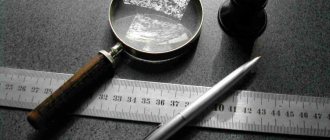Important! If you are handling your own theft case, you should remember that:
- Each case is unique and individual.
- Knowledge of the laws is desirable, but does not guarantee a solution to your particular problem .
- The possibility of a positive outcome depends on many factors .
Get a free consultation with a lawyer with the support of the Ministry of Justice of the Russian Federation
When investigating various categories of crimes, including thefts, special knowledge is required to secure evidence or establish certain facts. For this purpose, forensic examinations are appointed. The expert's opinion will be one of the most important evidence in the case.
Forensic characteristics of thefts
The concept of theft is disclosed in Art. 158 of the Criminal Code of the Russian Federation is the theft of someone else’s property or funds with the aim of disposing of them at one’s own discretion or converting them in favor of other persons. A feature of this type of act is the absence of signs of violent actions when taking possession of other people’s valuables, as well as the secret nature of the thief’s actions.
Let us highlight the important nuances that characterize the theft of money or property assets:
- it is considered an administrative offense if the amount of damage does not exceed 2,500 rubles;
- Art. 158 of the Criminal Code of the Russian Federation contains a delimitation of the amount of damage, which affects the punishment of the offender:
- significant size (at least 5,000 rubles);
- major damage (at least 250 thousand rubles);
- especially large size (at least a million rubles);
Art. 158 of the Criminal Code of the Russian Federation contains a number of additional factors that influence the possible type of punishment:
- amount of damage;
- crime of a group of persons or an organized group;
- theft from someone else's home;
- theft from personal belongings or items that were with the victim, etc.
Note!
Most of the indicated signs of theft can only be proven with the help of examinations ordered by an investigator or court.
Order of conduct
In order to remove unusable assets from an organization’s balance sheet, it will first be necessary to determine whether their further exploitation has no real basis. This task is assigned to a special commission, approved in a special manner, which is tasked with confirming the presence of facts of wear, defects, or the absence of material assets due to shortages.
The verdict of a malfunction is the basis for drawing up an act for writing off the OS, a sample of which we will consider later. This document, properly executed, allows you to draw up an order, which contains an order from the management of the enterprise to remove assets from the general balance sheet. After this, the results of joint work are transferred to the accounting department, which carries out the procedure for reducing the value of fixed assets, and the object itself is disposed of, given away on a voluntary basis, or sold on the secondary market - if there is appropriate demand.
The role of forensic examinations in theft investigation
Forensic examination is an independent procedural event, its procedure is regulated by the Code of Criminal Procedure of the Russian Federation. A specialist with special knowledge in the field of science, technology, etc. is appointed to carry it out.
Let us highlight the main characteristics of such studies, which determine their important role in the investigation of thefts:
- the examination can be carried out at the pre-investigation stage or after the initiation of a case;
- the expert's conclusion is recognized as evidence in the case;
- All participants in a criminal case (investigator, victim accused, lawyer, etc.) have the right to propose questions.
Note!
If doubts arise about the objectivity or reliability of the specialist’s conclusions, the participants in the case have the right to file a petition for a repeat or additional examination. An unjustified refusal to satisfy such a request may be appealed to a higher official, prosecutor or in court.
Example of filling out OS 4 form for write-off
The procedure for completing the standard form provides for sequential entry of data, eliminating possible errors and discrepancies with basic recommendations. On the front side of the document, at the top, the following information is indicated:
- name of the enterprise;
- TIN and checkpoint;
- structural subdivision.
The last point is determined by the need to clarify the department or branch on whose balance sheet the fixed asset to be withdrawn is listed.
Next, information is entered on the grounds that served as a factor for making the decision on partial or complete liquidation. As a rule, a link is provided to one of the related acts or orders of the management team, supplemented by the data of the full-time employee who is financially responsible for the goods and materials in question (only the last name, first name and patronymic are indicated).
On the right side of the standard form, fill out the following sections:
- Code according to the All-Russian Classifier of Enterprises and Organizations.
- The date of drawing up the act on writing off the asset from accounting.
- Details of the document that served as the basis for the implementation of the procedure.
- Personnel number of the employee assigned to be responsible for the property.
Below is information about the serial numeric code assigned to the form, the actual reasons for the disposal of the fixed asset, as well as standard details. A separate free space is allocated for the approval and signature of the head of the organization.
After this, you need to move on to the next tabular part of the form, the content of which is directly related to the material assets to be written off. The procedure for specifying information looks like this.
| Column no. | Content |
| 1 | Nomenclature name of the object |
| 2-3 | Inventory and factory registration number, respectively |
| 4-5 | Dates of actual issue and crediting to the balance sheet of the enterprise |
| 6 | The actual duration of operation, that is, all periods during which inventories were actually used in production and management processes |
| 7 | Monetary value determined at the time of registration |
| 8 | Amount of depreciation charges during use |
| 9 | Residual value, defined as the difference between the values from points 7 and 8 |
The most typical forensic examinations in the investigation of thefts
Based on the characteristics of a crime such as theft, the following types of forensic examinations can be distinguished:
- fingerprinting – an expert examines fingerprints found at a crime scene or stolen objects to identify the criminal;
- traceological - study of traces of a criminal, a break-in at a residential premises or locks on a storage facility, etc.;
- merchandising - signs of stolen valuables are established, the correspondence of some of the found items to the remaining lot, etc.;
- accounting - in case of theft of goods from an enterprise, when it is necessary to establish the amount of damage based on primary receipt documents;
- other types in various fields of science, craft, technology, etc.
The burden of proving guilt in committing a crime rests with the prosecution. Since the inquiry officer or investigator does not have the specified special knowledge, only the conclusions of an expert can clarify certain facts.
To get the most detailed advice on your issue, you just need to follow any of the suggested options:
|
How to draw up an act correctly
Completion of the first stage, in which the newly created working group is involved, allows us to move on to the next stage. The document flow regulations allow the use of various types of forms for writing off fixed assets, the choice between which is determined by the specifics of a particular situation. Current forms include:
- OS-4 is a standard template used when deregistering one object, with the exception of situations when it comes to road transport.
- OS-4a is a modification developed specifically for the above exceptions.
- OS-4b is a type of standard document filled out when disposing of several inventory items at once.
The regulation approving the procedure for preparing these forms is Goskomstat Resolution No. 7, published in 2003.
The generated documentation confirming the decision to write off implies the need to promptly reflect the operation in inventory books and cards, as well as accounting programs used to control the storage and movement of fixed assets. This recommendation is mentioned in paragraph 80 of the Methodological Instructions of the Ministry of Finance, which determines the significance of the procedure. As a rule, when maintaining document flow, standard documents are filled out in the following format:
- Inventory cards No. OS-6 for separate accounting of inventory and property assets.
- Forms corresponding to sample No. OS-6a are relevant in cases where assets belong to group categories.
- Inventory books of small enterprises - No. OS-6b.
The specified accounting documentation is also regulated by the already mentioned resolution of the State Statistics Committee.
The importance of examinations for investigation
The expert's conclusion must accurately answer all the questions set out in the decision of the investigator or court. If violations are detected during the examination or the specialist does not have the necessary qualifications, the document may be considered unacceptable evidence. In this case, the lawyer will file a motion to exclude him from the case file, which will significantly complicate the process of incriminating evidence in criminal proceedings.
The expert’s conclusions allow us to establish the following circumstances:
- the identity of the criminal and his sanity - when examining traces of a crime (fingerprints, shoe prints, etc.);
- the exact size of the stolen property;
- method of theft - by illegally entering someone else's home, etc.;
- the presence of mitigating and aggravating circumstances.
The expert's conclusions will be assessed by the court when considering the case materials. If they contradict, a repeat or additional examination may be prescribed.
How can MCEO help?
In addition to material items, sometimes things that have no economic value are stolen. These can be manuscripts, dissertations, theses, valuable documents, handicrafts, and so on. The professional training of MCEO experts and appraisers allows us to establish the amount of damage from the theft of all of the above valuables and submit a report to the court containing all the results obtained as a result of a thorough study.
In some cases, the appraiser has to examine not the theft itself, but the documentation related to it. This may be due to the absence of the stolen item or its complete loss of its original properties. In these cases, an experienced appraiser also calculates the amount of damage caused, guided not only by the data specified in the documentation, but also by his own knowledge.
The assessment of damage from theft is more of a legal nature than an economic one. The final amount is determined by the court. However, an equally important role is assigned to the appraiser, who establishes the market value of the stolen property. The appraiser also has the right to act in court as an expert. Consequently, the fundamental document during a trial is its conclusion determining the cost of damage.
The conclusion must be made in accordance with the requirements of Law of the Russian Federation No. 73, which regulates the appraisal activities of organizations and companies of the relevant specifics.
The significant advantages of MCEO are the independent performance of expert and assessment work, as well as the provision of legal support to clients, which significantly increases the chance of receiving compensation for damage in the amount corresponding to the loss. By calling, you will learn about the rules for conducting an assessment and will be able to consult with a specialist.
How and for how long to store the document
The storage procedure involves placing the forms first in the general catalog of current documentation, using a separate identifying folder, and then in the archive - after the expiration date. The duration, determined by regulations as well as internal rules of the organization, may vary, but must be at least three years, after which destruction is permitted.
So, now you know what to write in the OS 4 form, and what results of write-off of fixed assets are recorded in the reporting.
It's time to simplify the accounting of enterprise property by taking advantage of practical mobile automation solutions from. Number of impressions: 2228







